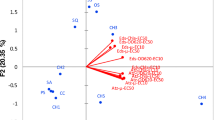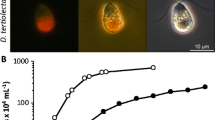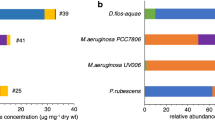Abstract
The Biodegradation capabilities of six selected cyanobacterial species for fluometuron, a phenylurea herbicide, as well as its inhibitory effect on chlorophyll a content were investigated. The selected species (three strains of Microcystis aeruginosa, Anabaena cylindrica, A. flos-aquae and A. spiroides) were subjected to three elevated concentrations of fluometuron (0.14, 0.7 and 1.4 mg/ml) for different exposure times (1–5 days). Results revealed that biodegradation of fluometuron is species-dependent and positively correlated with the exposure time, reaching maximum efficiency after 5 days at all the investigated concentrations. All the species tested showed generally great ability to degrade the compound even at the highest concentration with specific variations among them. Biodegradation efficiencies of fluometuron by the selected species were in the following ranges; 39.2–99.9; 87.5–100; and 93.2–100 at 0.14; 0.7 and 1.4 mg fluometuron/ml respectively. It was noticed that the gradual increase in the pesticide concentration enhances its biodegradability by the selected algal species. Variations according to species as well as exposure time were discussed. The highest fluometuron concentration (1.4 mg/l) showed the highest inhibition of chlorophyll a content in the tested species and toxicity was also species- and time-dependent.
Similar content being viewed by others
References
Barque, J.P., Abahamid, A., Bourezgui, Y., Chacun, H. & Bonaly, J. 1995 Protein synthesis in cadmium-and pentachlorophenoltolerant Euglena gracilis. Environmental Research 70, 70–74.
Clesceri, L.S., Greenberg, A.E. & Eaton, A.D. 1998 Standard Methods for the Examination of Water and Wastewater, 20th edn. American Public Health Association (APHA), American Water Works Association, Water Environment Federation, Washington. ISBN 0-87553-235-7.
Cuppen, J.G., Van den Brink, P.J., Van der Woude, H., Zwaardernaker, N. & Brock, T.C. 1977 Sensitivity of macrophyte-dominated freshwater microcosmos to chronic levels of the herbicide linuron. II. Community metabolism and invertebrates. Ecotoxicology and Environmental Safety 38, 25–35.
El-Sheekh, M.M., Kotkat, H.M. & Hammouda, O.H. 1994 Effect of atrazine herbicide on growth, photosynthesis, protein synthesis, and fatty acid composition in the unicellular green alga Chlorella kessleri. Ecotoxicology and Environmental Safety 29, 349–358.
Ernst, W., Schaefer, R.C., Goerke, R.C. & Eder, G. 1974 Preparation of marine animals for determination of PCB, DDT, DDE, HCH and HCB. Analytical Chemistry 272, 358–363.
Fear, D.S. 1968 Microsomal N-demethylation by a cotton leaf oxidase system of 3-(P-chlorophyenyl)-1,1-dimethylurea (monuron). Science 162, 674–675.
Frear, D.S. & Swanson, H.R. 1969 Metabolism of urea herbicides in plants: isolation and characterization of a microsomal N-demethylase from cotton. Abstract paper, 157th National Meeting of Analytical Chemical Society, AGFD 15.
International Agency for Research on Cancer (IARC) 1983 IARC monographs on the evaluation of the carcinogenic risk of chemicals to humans. 30, 245–253.
Kaufman, D.D. 1977 Biodegradation and persistence of several acetamide, acylanilide, azide, carbamate, and organophosphate pesticide combinations. Soil Biology and Biochemistry 9, 49–57.
Matsue, T., Koike, S. & Uchida, I. 1993 Microamperometric estimation of photosynthesis inhibition in a single algal protoplast. Biochemical and Biophysical Research Communications 197, 1283–1287.
Megharaj, M., Venkateswarlu, K. & Rao, A.S. 1987 Influence of cypermethrin and fenvalerate on a green alga and three cyanobacteria isolated from soil. Ecotoxicology and Environmental Safety 14, 142–146.
Megharaj, M., Madhavi, D.R., Sreenivasulu, C., Umamaheswari, A. & Venkateswarlu, K. 1994 Biodegradation of methyl parathion by soil isolates of microalgae and cyanobacteria. Bulletin of Environmental Contamination & Toxicology 53, 292–297.
Oettmeier, W. 1999 Herbicide resistance and supersensitivity in photosystem II. Cell and Molecular Life Science 55, 1255–1277.
Ross, J.A. & Tweedy, B.G. 1973 Degradation of four phenylurea herbicides by mixed populations of microorganisms from two soil types. Soil Biology and Biochemistry 5, 739–746.
Shafik, M. & Khogali, A. 1995 Effect of some urea-herbicides on some activities of Echhornia Crassipes (Mart). Bulletin of Faculty of Science, Alexandria University 35, 91–100.
Sobolev, V. & Edelman, M. 1995 Modeling the quinone-B binding site of the photosystem-II reaction center using notions of complementarily and contact-surface between atoms. Proteins 21, 214–225.
Sumida, S., Yoshida, R. & Ueda, M. 1975 Studies of pesticide effects on Chlorella metabolism II. Effect of DCMU on galactolipid metabolism. Plant and Cell Physiology 16, 257–264.
Thies, F., Backhaus, T., Bossmann, B. & Grimme, L.H. 1996 Xenobiotic biotransformation in unicellular green algae. Involvement of cytochrome P450 in the activation and selectivity of the pyridazinone pro-herbicide metflurazon. Plant Physiology 112, 361–370.
Thompson, R.J. & Mosig, G. 1990 Light affects the structure of Chlamydomonas Chloroplast chromosomes. Nucleic Acids Research 18, 2625–2631.
US Department of Transportation 1996 North American Emergency Response Guidebook. A Guidebook for First Responders During the Initial Phase of a Hazardous Materials/Dangerous Goods Incident.US Department of Transportation (US DOT) Research and Special Programs Administration, Office of Hazardous materials Initiatives and Training (DHM-50), Washington, DC.
Van den Brink, P.J., Hartgers, E.M., Fettweis, U., Crum, S.J.H., Van Donk, E. & Brock, T.C.M. 1997 Sensitivity of macorophytedominated freshwater microcosms to chronic levels of the herbicide linuron. Ecotoxicology and Environmental Safety 38, 13–24.
Weber, J.B. & Miller, C.T. 1989 Reactions and Movement of Organic Chemicals in Soils. Soil Science Society of America Special Publication no. 22, 305–333. ISBN 0-89118788-X.
Weed Science Society of America (WSSA) 1979 Herbicide Handbook, 4th edn. Champaign, Illinois: Weed Science Society of America, 1979.
Weinberger, M. & Bollag, J.M. 1972 Degradation of Chlorobromuron and related compounds by the fungus Rhizoctonia solani. Applied Microbiology 24, 750–754.
Winder, T. & Splading, M.H. 1988 Imazaquin and chlorsulfuran resistance and cross-resistance in mutants of Chlamydomonas reinhardtii. Molecular and Genenral Genetics 213, 394–399.
WSSA 1989 Herbicide Handbook of the Weed Science Society of America. 6th edn. Champaign, IL: Weed Science Society of America, 136–137. ISBN 0-91173313-2.
Xiong, J., Minagawa, J., Crofts, A. & Govindjee, 1998 Loss of inhibition by formate in newly constructed photosystem II D1 mutants, D1-R257E and D1-R257M, of Chlamydomonas reinhardtii. Biochimica et Biophysica Acta 1365, 473–491.
Author information
Authors and Affiliations
Rights and permissions
About this article
Cite this article
El-Rahman Mansy, A., El-Bestawy, E. Toxicity and biodegradation of fluometuron by selected cyanobacterial species. World Journal of Microbiology and Biotechnology 18, 125–131 (2002). https://doi.org/10.1023/A:1014490811121
Issue Date:
DOI: https://doi.org/10.1023/A:1014490811121




